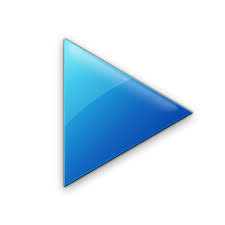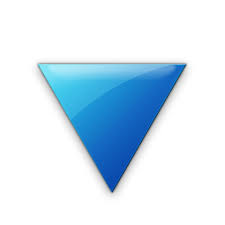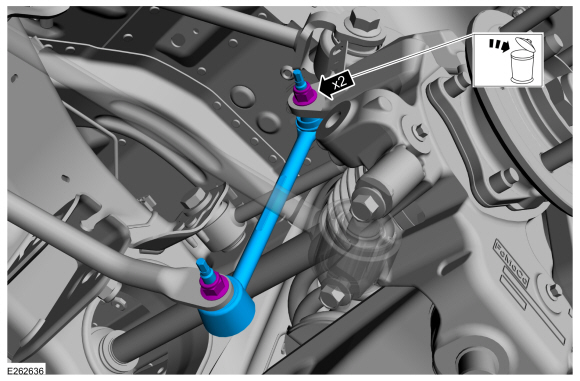Lincoln Navigator: Front Drive Halfshafts / Front Drive Halfshafts. Diagnosis and Testing
Preliminary Inspection
-
Visually inspect the CV joints, housing, boots, and clamps for obvious signs of mechanical damage.
-
If an obvious cause for an observed or reported concern is
found, correct the cause (if possible) before proceeding to the next
step
-
If the cause is not visually evident, verify the symptom and REFER to Symptom Chart: NVH.
Symptom Chart(s)
Diagnostics in this manual assume a certain skill level and knowledge of Ford-specific diagnostic practices.
REFER to: Diagnostic Methods (100-00 General Information, Description and Operation).
Symptom Chart: NVH
Symptom Chart
| Condition | Actions |
|---|---|
| Axle howling or whine – front or rear axle | GO to Pinpoint Test A |
| Driveline clunk - loud clunk when shifting from REVERSE to DRIVE | GO to Pinpoint Test B |
| Driveline clunk (Front Wheel Drive (FWD) vehicles) — occurs during acceleration or from cruise to coast/deceleration | GO to Pinpoint Test C |
| Driveline clunk — occurs as the vehicle starts to move forward following a stop | GO to Pinpoint Test D |
| Clicking, popping or grinding - occurs while the vehicle is turning | GO to Pinpoint Test E |
| Grunting — normally associated with a shudder experienced during acceleration from a complete stop | GO to Pinpoint Test F |
| Driveline vibration - occurs at cruising speeds | GO to Pinpoint Test G |

 PINPOINT TEST A: AXLE HOWLING OR WHINE – FRONT OR REAR AXLE
PINPOINT TEST A: AXLE HOWLING OR WHINE – FRONT OR REAR AXLE |
Normal Operation and Fault Conditions Halfshafts transmit rotary motion through constant velocity joints in a uniform manner. The outer CV joints use balls, have no length compensation and engage in the wheel hubs. The intermediate shaft (right side) is correctly positioned and secured in the differential by the intermediate shaft center bearing. The left CV joint is locked in the differential by a snap-ring. Possible Sources
|
||||
| A1 INSPECT WHEEL HUB BEARINGS | ||||
Was any wheel hub bearing play or damage found?
|

 PINPOINT TEST B: DRIVELINE CLUNK- LOUD CLUNK WHEN SHIFTING FROM REVERSE TO DRIVE
PINPOINT TEST B: DRIVELINE CLUNK- LOUD CLUNK WHEN SHIFTING FROM REVERSE TO DRIVE|
Normal Operation and Fault Conditions Halfshafts transmit rotary motion through constant velocity joints in a uniform manner. The outer CV joints use balls, have no length compensation and engage in the wheel hubs. The intermediate shaft (right side) is correctly positioned and secured in the differential by the intermediate shaft center bearing. The left CV joint is locked in the differential by a snap-ring. Possible Sources
|
||||
| B1 CHECK THE HUB NUT TORQUE | ||||
Is the hub nut loose?
|
||||
| B2 CHECK THE CONSTANT VELOCITY (CV) BOOTS AND JOINTS FOR WEAR OR DAMAGE | ||||
Was damage found?
|
||||
| B3 CHECK THE TORQUE ON SUSPENSION AND STEERING SYSTEM FASTENERS | ||||
Is the any of the suspension and steering fastener loose?
|

 PINPOINT
TEST C: DRIVELINE CLUNK (FRONT WHEEL DRIVE (FWD) VEHICLES) — OCCURS
DURING ACCELERATION OR FROM CRUISE TO COAST/DECELERATION
PINPOINT
TEST C: DRIVELINE CLUNK (FRONT WHEEL DRIVE (FWD) VEHICLES) — OCCURS
DURING ACCELERATION OR FROM CRUISE TO COAST/DECELERATION |
Normal Operation and Fault Conditions Halfshafts transmit rotary motion through constant velocity joints in a uniform manner. The outer CV joints use balls, have no length compensation and engage in the wheel hubs. The intermediate shaft (right side) is correctly positioned and secured in the differential by the intermediate shaft center bearing. The left CV joint is locked in the differential by a snap-ring. Possible Sources
|
||||
| C1 CHECK THE HUB NUT TORQUE | ||||
Is the hub nut loose?
|
||||
| C2 CHECK THE CONSTANT VELOCITY (CV) BOOTS AND JOINTS FOR WEAR OR DAMAGE | ||||
Was damage found?
|
||||
| C3 CHECK THE TORQUE ON SUSPENSION AND STEERING SYSTEM FASTENERS | ||||
Is the any of the suspension and steering fastener loose?
|

 PINPOINT TEST D: DRIVELINE CLUNK — OCCURS AS THE VEHICLE STARTS TO MOVE FORWARD FOLLOWING A STOP
PINPOINT TEST D: DRIVELINE CLUNK — OCCURS AS THE VEHICLE STARTS TO MOVE FORWARD FOLLOWING A STOP |
Normal Operation and Fault Conditions Halfshafts transmit rotary motion through constant velocity joints in a uniform manner. The outer CV joints use balls, have no length compensation and engage in the wheel hubs. The intermediate shaft (right side) is correctly positioned and secured in the differential by the intermediate shaft center bearing. The left CV joint is locked in the differential by a snap-ring. Possible Sources
|
||||
| D1 CHECK FOR LOOSE HUB NUT | ||||
Are any hub nuts loose?
|
||||
| D2 CHECK THE TORQUE ON SUSPENSION AND STEERING SYSTEM FASTENERS | ||||
Is the any of the suspension and steering fastener loose?
|

 PINPOINT TEST E: CLICKING, POPPING OR GRINDING - OCCURS WHILE THE VEHICLE IS TURNING
PINPOINT TEST E: CLICKING, POPPING OR GRINDING - OCCURS WHILE THE VEHICLE IS TURNING |
Normal Operation and Fault Conditions Halfshafts transmit rotary motion through constant velocity joints in a uniform manner. The outer CV joints use balls, have no length compensation and engage in the wheel hubs. The intermediate shaft (right side) is correctly positioned and secured in the differential by the intermediate shaft center bearing. The left CV joint is locked in the differential by a snap-ring. Possible Sources
|
||||
| E1 CHECK THE CONSTANT VELOCITY (CV) BOOTS AND JOINTS FOR WEAR OR DAMAGE | ||||
Was wear or damage found?
|
||||
| E2 CHECK THE HALFSHAFTS FOR CONTACT WITH ANOTHER COMPONENT | ||||
Is there contact between other components with the halfshaft?
|
||||
| E3 INSPECT THE HALFSHAFT OR HALFSHAFT CIRCLIP | ||||
Was any damage found?
|

 PINPOINT TEST F: GRUNTING — NORMALLY ASSOCIATED WITH A SHUDDER EXPERIENCED DURING ACCELERATION FROM A COMPLETE STOP
PINPOINT TEST F: GRUNTING — NORMALLY ASSOCIATED WITH A SHUDDER EXPERIENCED DURING ACCELERATION FROM A COMPLETE STOP |
Normal Operation and Fault Conditions Halfshafts transmit rotary motion through constant velocity joints in a uniform manner. The outer CV joints use balls, have no length compensation and engage in the wheel hubs. The intermediate shaft (right side) is correctly positioned and secured in the differential by the intermediate shaft center bearing. The left CV joint is locked in the differential by a snap-ring. Possible Sources
|
||||
| F1 CHECK THE OUTER CONSTANT VELOCITY (CV) JOINT FOR CORRECT SEATING INTO THE HUB | ||||
Is the outer Constant Velocity (CV) joint seated correctly into the hub?
|

 PINPOINT TEST G: DRIVELINE VIBRATION - OCCURS AT CRUISING SPEEDS
PINPOINT TEST G: DRIVELINE VIBRATION - OCCURS AT CRUISING SPEEDS |
Normal Operation and Fault Conditions Halfshafts transmit rotary motion through constant velocity joints in a uniform manner. The outer CV joints use balls, have no length compensation and engage in the wheel hubs. The intermediate shaft (right side) is correctly positioned and secured in the differential by the intermediate shaft center bearing. The left CV joint is locked in the differential by a snap-ring. Possible Sources
|
||||
| G1 CHECK THE OUTER CONSTANT VELOCITY (CV) JOINT FOR CORRECT SEATING INTO THE HUB | ||||
Is the outer Constant Velocity (CV) joint seated correctly into the hub?
|
 Halfshaft. Removal and Installation
Halfshaft. Removal and Installation
Special Tool(s) /
General Equipment
204-592Separator, Lower Arm Ball JointTKIT-2006C-FFMFLMTKIT-2006C-LMTKIT-2006C-ROW
Tie Rod End Remover
Tire Lever
Removal
NOTICE:
Suspension fasteners are critical parts that affect the
performance of vital components and systems...
Other information:
Lincoln Navigator 2018-2025 Workshop Manual: Telematics Control Unit (TCU) Module Antenna. Removal and Installation
Removal NOTE: Removal steps in this procedure may contain installation details. Remove the instrument panel. Refer to: Instrument Panel (501-12 Instrument Panel and Console, Removal and Installation). Remove the bolts, separate the wire harness guide, disconnect and remove the TCU antenna...
Lincoln Navigator 2018-2025 Workshop Manual: Charge Air Cooler (CAC) Outlet Pipe. Removal and Installation
Removal NOTICE: The turbocharger compressor vanes can be damaged by even the smallest particles. When removing any turbocharger or engine air intake system component, ensure that no debris enters the system. Failure to do so may result in damage to the turbocharger...
Categories
- Manuals Home
- 4th Gen Lincoln Navigator Service Manual (2018 - 2025)
- Liftgate Trim Panel. Removal and Installation
- Vehicle Dynamics Control Module (VDM). Removal and Installation
- All Terrain Control Module (ATCM). Removal and Installation
- Front Bumper Cover. Removal and Installation
- Telematics Control Unit (TCU) Module. Removal and Installation
Rear Stabilizer Bar Link. Removal and Installation
Removal
NOTE: Removal steps in this procedure may contain installation details.
With the vehicle in NEUTRAL, position it on a hoist.Refer to: Jacking and Lifting (100-02 Jacking and Lifting, Description and Operation).
NOTE: Use the hex-holding feature to prevent the stud from turning while removing the nut.
Remove and discard the 2 rear stabilizer bar link nuts and remove the rear stabilizer bar link.Torque: 46 lb.ft (63 Nm)


